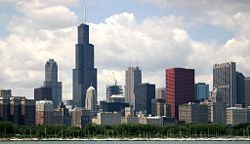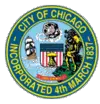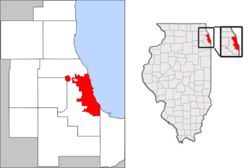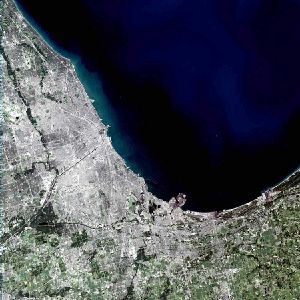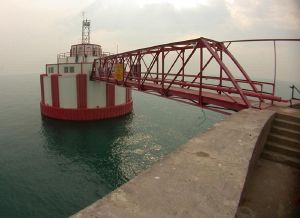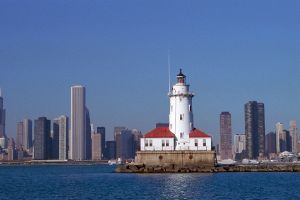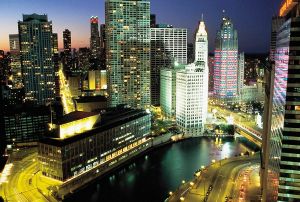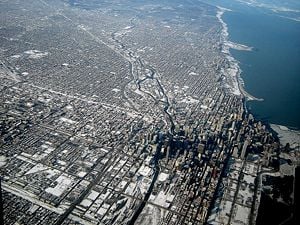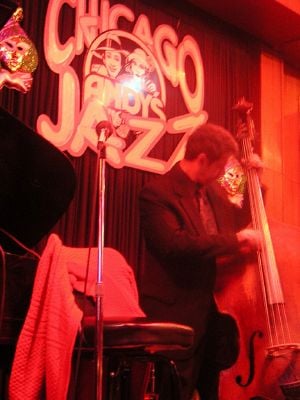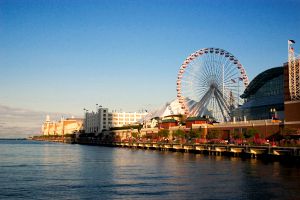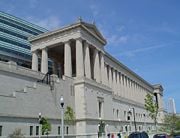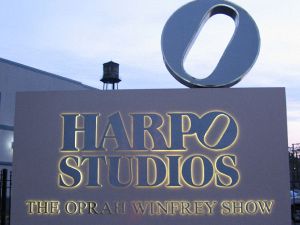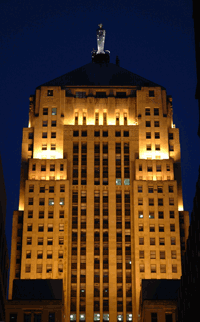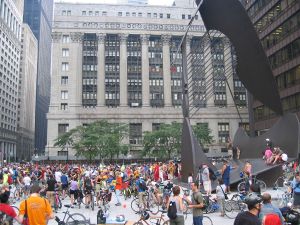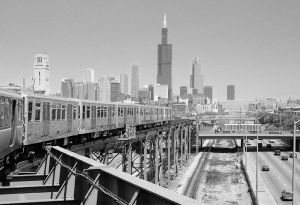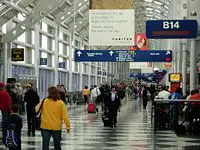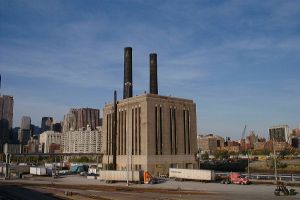Chicago
| City of Chicago | |||
|
|||
| Nickname: "The Windy City," "The Second City," "ChiTown," "Hog Butcher for the World," "City of the Big Shoulders," "The City That Works," "Da Chi" | |||
| Motto: "Urbs in Horto" (Latin: "City in a Garden"), "I Will" | |||
| Location in the Chicago metro area and Illinois | |||
| Coordinates: {{#invoke:Coordinates|coord}}{{#coordinates:41|52|55|N|87|37|40|W|type:city | |||
|---|---|---|---|
| name= }} | |||
| Country | United States | ||
| State | Illinois | ||
| Counties | Cook, DuPage,Lake County | ||
| Settled | 1770s | ||
| Incorporated | March 4 1837 | ||
| Government | |||
| - Mayor | Richard M. Daley (D) | ||
| Area | |||
| - City | 234.0 sq mi (606.2 km²) | ||
| - Land | 227.2 sq mi (588.3 km²) | ||
| - Water | 6.9 sq mi (17.9 km²) 3.0% | ||
| - Urban | 2,122.8 sq mi (5,498.1 km²) | ||
| - Metro | 10,874 sq mi (28,163 km²) | ||
| Elevation | 586 ft (179 m) | ||
| Population (2006) | |||
| - City | 2,833,321 | ||
| - Density | 12,470/sq mi (4,816/km²) | ||
| - Urban | 8,711,000 | ||
| - Metro | 9,505,747 | ||
| Time zone | CST (UTC-6) | ||
| - Summer (DST) | CDT (UTC-5) | ||
| Website: egov.cityofchicago.org | |||
Chicago is the largest city in the state of Illinois and the largest in the Midwest. With a population of nearly 3 million people, the city is the third largest in the United States. It is the anchor of the Chicago metropolitan area, commonly called Chicagoland, which has a population of over 9.7 million people in Illinois, Wisconsin and Indiana, making it the third largest metropolitan area in the U.S.[1] Rich in history and renowned for its architecture, the city is almost entirely located in Cook County, Illinois, with a small portion overlapping into DuPage County, while the metropolitan area extends over several counties.
Located at the site of a portage between the Great Lakes and the Mississippi River watershed, Chicago was incorporated as a city in 1837. It rapidly became a major transportation hub, as well as the business, financial, and cultural capital of the Midwest. Since the Chicago World's Fair of 1893, it has been regarded as one of the ten most influential cities in the world.
Geography
Topography
Chicago is a midwestern city, located in northeastern Illinois at the southwestern tip of Lake Michigan. It sits on the continental divide at the site of the Chicago Portage, connecting the Mississippi River and the Great Lakes watersheds. The city lies beside Lake Michigan, and two rivers—the Chicago River in downtown and the Calumet River in the industrial far South Side—flow entirely or partially through Chicago. The Chicago Sanitary and Ship Canal connects the Chicago River with the Des Plaines River, which runs to the west of the city.
When Chicago was founded in the 1830s, most of the early building began around the mouth of the Chicago River, as can be seen on a map of the city's original 58 blocks. According to the U.S. Census Bureau, which analyzes the city using 77 official community areas, Chicago has a total area of 234.0 square miles (606.1 km²).
The city is built on quite flat land. The average land elevation land is 579 feet (176 m) above sea level. The highest point at 735 feet (224 m) is a landfill located on the city's far south side.
Lake Michigan
The history of Chicago is closely tied to that of Lake Michigan. Since before Chicago was founded, ships were bringing people and supplies from all points on the compass. Lake Michigan is the third largest of the Great Lakes, with a maximum depth of 925 feet (282 m) and a size slightly greater than the country of Croatia. The average depth off Chicago’s shore averages 15–35 feet. To reach greater depths, one must travel several miles out in the lake, or head north to Milwaukee, Wisconsin. The lake bottom off Chicago’s shore is littered with shipwrecks, ranging from schooners and tugboats to car ferries and even World War II airplanes. Scuba diving is a popular recreation for local residents, as are lakefront cruises. Zebra mussels were discovered in Lake Saint Clair in 1988 and soon spread, impacting the ecosystem.
Climate
The city lies within the humid continental climate zone, and experiences four distinct seasons. In July, the warmest month, high temperatures average 84.9 °F (29.4 °C) and low temperatures 65.8 °F (18.8 °C). In January, the coldest month, high temperatures average 31.5 °F (−0.3 °C) with low temperatures averaging 17.1 °F (−8.3 °C). According to the National Weather Service, Chicago’s highest official temperature reading of 105 °F (41 °C) was recorded on July 24, 1934. The lowest temperature of −27 °F (−33 °C) degrees was recorded on January 20, 1985.
Chicago’s yearly precipitation averages about 34 inches. Summer is the rainiest season, with short-lived rainfall and thunderstorms more common than prolonged rainy periods. Winter is the driest season, with most of the precipitation falling as snow. The snowiest winter ever recorded in Chicago was 1929–1930, with 114.2 inches of snow in total. Chicago’s highest one-day rain total was 6.49 inches (164 mm), on August 14, 1987.
Architecture
The outcome of the Great Chicago Fire led to the largest building boom in the history of the nation. Perhaps the most outstanding of these events was the relocation of many of the nation's most prominent architects to the city from New England for construction of the 1893 World Columbian Exposition. Many architects went on to design other well-known Chicago landmarks because of the Exposition.
In 1885, the first steel-framed high-rise building rose in Chicago ushering in the skyscraper era. Today, Chicago's skyline is among the world's tallest. Downtown's historic buildings include the Chicago Board of Trade Building in the Loop, with others along the lakefront and the Chicago River. Once first on the list of largest buildings in the world and still listed sixth, the Merchandise Mart stands near the junction of the north and south river branches. The three tallest in the city are the Sears Tower (currently the tallest in the Western Hemisphere), the Aon Center, and the John Hancock Center. The city's architecture includes lakefront high-rise residential towers, low-rise structures, and single-family homes. Industrialized areas such as the Indiana border, south of Midway Airport, and the banks of the Chicago Sanitary and Ship Canal are clustered.
Future skyline plans entail the supertall Waterview Tower, Chicago Spire, and Trump International Hotel and Tower. The 60602 zip code was named by Forbes as the hottest zip code in the country with upscale buildings such as The Heritage at Millennium Park (130 N. Garland) leading the way for other buildings such at Waterview Tower, The Legacy and Momo. Other new skyscraper construction may be found directly south (South Loop) and north (River North) of the Loop.
Every kind and scale of houses, townhouses, condominiums and apartment buildings can be found in Chicago. Large swaths of Chicago's residential areas away from the lake are characterized by bungalows built either during the early 20th century or after World War II. Chicago was a center of the Polish Cathedral style of church architecture.
Parks line Lake Shore Drive; a few of the more notable include Grant Park, Millennium Park, and Lincoln Park. Burnham Park and Jackson Park in Hyde Park are to the south. Interspersed are 31 beaches in Chicago, the Lincoln Park Zoo, several bird sanctuaries, McCormick Place Convention Center, Navy Pier, Soldier Field, the Museum Campus, and the Jardine Water Purification Plant.
Neighborhoods
Regionally, Chicago can be divided by the river and its branches into three main sections: the North Side, the South Side, and the West Side. In the late 1920s the city was subdivided into 77 "community areas" by sociologists at the University of Chicago. The boundaries of the community areas are better defined than those of the over 210 neighborhoods throughout the city, allowing for better year-by-year comparisons.
Downtown and The Loop
The downtown area, lying somewhat roughly between Division Street on the north, Lake Michigan on the east, Roosevelt Road on the south and Halsted on the west, is the main commercial and cultural section of the city and includes the city's tallest buildings. In recent years, downtown has become so popular it has taken on the additional role as a residential enclave, with a high number of residents living there. The area of the Loop, located within downtown, was named for a circuit of cable cars and later for the elevated train Loop where practically all branches of the CTA elevated and subway trains lead. Some of downtown's commercial, cultural, and financial institutions are located in the Loop. The Chicago Bears of the NFL also play downtown, in Soldier Field.
Beyond that is the Growing South Loop Area Bridgeport, Chinatown, Canaryville and up to 46th street and Halsted Street. The furthest sout loop business is the http://www.chicagosafetyinstitute.com home of international businesses like www.safetypacific.com that sets up international business logistics and marketing about a mile and half South of the Chicago White Sox and just South of the Chicago Stock Yards. The area is racially mixed of all creeds colors and ethinics mostly Scotch and Irish, Chinese, few Afro American more near the Dan Ryan and East, Italian and a growing Filipino community. The Chicago Stock Yards are what put Chicago on the map and made it a major business city. Now the extreme South Loop area is industrial and comercial mixed residential; as the Cattle men have pulled out leaving behind high demand realestate and business area. The other thing that distinguishes the South Loop is the Teamsters Union you remember Mr. Hoffa don't you who mysteriously disappeared in Chicago.
The main thing the South Loop has is the World Champion 2005 World Series Chicago White Sox http://www.whitesox.com that put the South Loop on the map again.
North Side
The city's North Side is the most densely populated residential section of the city.
Much of the North Side reaped the benefits of an economic boom which began in the 1990s. For example, the River North area, just north of the Chicago River and the Loop, has undergone a transition from an abandoned warehouse district to an active commercial, residential, and entertainment hub, featuring the city's largest concentration of contemporary art galleries. Just west of River North's galleries and bistros, demolition of the CHA's Cabrini-Green housing project began in 2003[2]. High-priced townhouses contrast with the gray, low-income high-rises along Halsted near Division Street.
South Side
The South Side encompasses roughly 60% of the city's land area, however, with a higher ratio of single-family homes and large sections zoned for industry, it is less densely populated than the North Side.
Along with being the largest section of the city in terms of geography, it also is the home to two of the cities largest parades: the annual Bud Billiken Day parade, which is held during the second weekend of August and celebrates children returning to school, and the South Side Irish Parade, which held the weekend of St.Patrick's Day.
The South Side has two of Chicago's largest public parks: Jackson Park, hosted the World's Columbian Exposition in 1893 is currently the site of the Museum of Science and Industry. The park stretches along the lakefront, linking the neighborhoods of Hyde Park and South Shore. Washington Park, which is connected to Jackson Park by the Midway Plaisance, is currently being considered as the primary site of the Olympic Stadium for the 2016 Summer Olympics if Chicago wins the bid.
West Side
The West Side (extending west of downtown) is made up of neighborhoods such as Austin, Lawndale, Garfield Park, West Town, and Humboldt Park among others. Some neighborhoods, particularly Garfield Park and Lawndale, have socio-economic problems including urban decay and crime. Other West Side neighborhoods, especially those closer to downtown, have been experiencing a rise in property value.
West Side parks includes Douglas Park, Garfield Park, and Humboldt Park. Garfield Park Conservatory houses one of the largest collections of tropical plants of any U.S. city. Other attractions on the West Side include the United Center (home of the Chicago Bulls of the NBA and Chicago Blackhawks of the NHL), Humboldt Park's Puerto Rican Day festival, and the National Museum of Mexican Art in Pilsen.
The West Side is serviced by three CTA rapid transit lines: The Green Line, Blue Line, and Pink Line.
Culture and contemporary life
The city's waterfront allure and nightlife has attracted residents and tourists alike. Over one-third of the city population is concentrated in the lakefront neighborhoods (from Rogers Park in the north to Hyde Park in the south). The North Side has a large gay and lesbian community. Two North Side neighborhoods in particular, Lakeview and the Andersonville area of the Edgewater neighborhood, are home to many LGBT businesses and organizations. The area adjacent to the North Side intersection of Halsted and Belmont is a gay neighborhood known to Chicagoans as "Boystown." The city has many upscale dining establishments as well as many ethnic restaurant districts. These include "Greektown" on South Halsted, "Little Italy" on Taylor Street, just west of Halsted, "Chinatown" on the near South Side, "Little Seoul" on and around Lawrence Avenue, a cluster of Vietnamese restaurants on Argyle Street and South Asian (Indian/Pakistani) on Devon Avenue.
Entertainment and performing arts
Chicago’s theater community spawned modern improvisational comedy. Two renowned comedy troupes emerged—The Second City and I.O. (formerly known as ImprovOlympic). Renowned Chicago theater companies include the Steppenwolf Theatre Company (on the city's north side), the Goodman Theatre, and the Victory Gardens Theater. Chicago offers Broadway-style entertainment at theatres such as Ford Center for the Performing Arts Oriental Theatre, LaSalle Bank Theatre, Cadillac Palace Theatre, Auditorium Theatre of Roosevelt University, and Drury Lane Theatre Water Tower Place.
Classical music offerings include the Chicago Symphony Orchestra, recognized as one of the finest orchestras in the world, which performs at Symphony Center. In the summer, many outdoor concerts are given in Grant Park and Millennium Park. The Ravinia Festival, located 25 miles (40 km) north of Chicago, is also a favorite destination for many Chicagoans, with performances occasionally given in Chicago locations such as the Harris Theater. The Civic Opera House is home to the Lyric Opera of Chicago.
The Joffrey Ballet and Chicago Festival Ballet perform in various venues, including the Harris Theater in Millenium Park. Chicago is home to several other modern and jazz dance troupes, such as the Hubbard Street Dance Chicago.
Other live music genre which are part of the city's cultural heritage include Chicago blues, Chicago soul, jazz, and gospel. The city is the birthplace of House Music and is the site of an influential hip-hop scene. In the 1980s, the city was a center for industrial, punk and new wave. This influence continued into the alternative music of the 1990s. The city has been an epicenter for rave culture since the 1980s. A flourishing independent rock music culture brought forth Chicago indie. Annual festivals feature various acts such as Lollapalooza, the Intonation Music Festival and Pitchfork Music Festival.
Many notable celebrities and entertainment figures are associated with Chicago.
Tourism
Chicago attracted 44.17 million people in 2006 from around the nation.[3] Upscale shopping along the Magnificent Mile, thousands of restaurants, as well as Chicago's eminent architecture, continue to draw tourists. The city is the United States' third-largest convention destination.[4] Most conventions are held at McCormick Place, just south of Soldier Field.
Navy Pier, 3,000 feet (900 m) long, houses retail, restaurants, museums, exhibition halls, and auditoriums. Its 150-foot (46 m) tall Ferris wheel is north of Grant Park on the lakefront and is one of the most visited landmarks in the Midwest, attracting about 8 million people annually.[5]
The historic Chicago Cultural Center (1897), originally serving as the Chicago Public Library, now houses the city's Visitor Information Center, galleries, and exhibit halls. The ceiling of Preston Bradley Hall includes a 38-foot (11 m) Tiffany glass dome.
Millennium Park, initially slated to be unveiled at the turn of the 21st century, and delayed for several years, sits on a deck built over a portion of the former Illinois Central rail yard. The park includes the reflective Cloud Gate sculpture (known locally as "The Bean"). A Millennium Park restaurant outdoor transforms into an ice skating rink in the winter. Two tall glass sculptures make up the Crown Fountain. The fountain's two towers display visual effects from LED images of Chicagoans' faces, with water spouting from their lips. Frank Gehry's detailed stainless steel band shell, Pritzker Pavilion, hosts the classical Grant Park Music Festival concert series. Behind the pavilion's stage is the Harris Theater for Music and Dance, an indoor venue for mid-sized performing arts companies, including Chicago Opera Theater and Music of the Baroque.
In 1998, the city officially opened the Museum Campus, a 10-acre (4-ha) lakefront park surrounding three of the city's main museums: the Adler Planetarium, the Field Museum of Natural History, and the Shedd Aquarium. The Museum Campus joins the southern section of Grant Park which includes the renowned Art Institute of Chicago. Buckingham Fountain anchors the downtown park along the lakefront. During the summer of 2007, Grant Park hosts the public art exhibit, Cool Globes: Hot Ideas for a Cooler Planet.
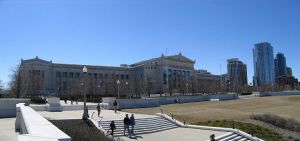
The Oriental Institute, part of the University of Chicago, has an extensive collection of ancient Egyptian and Near Eastern archaeological artifacts. Other museums and galleries in Chicago are the Chicago History Museum, DuSable Museum of African-American History, Museum of Contemporary Art, the Peggy Notebaert Nature Museum.
Cuisine
Chicago can lay claim to a number of regional specialties, all of which reflect the city's ethnic and working-class roots. Included among these are the nationally renowned deep-dish pizza—although locally the Chicago thin crust is also equally popular; the Chicago-style hot dog, typically a Vienna Beef dog loaded with an array of fixings that often includes Chicago's own neon green pickle relish, yellow mustard, pickled sport peppers, tomato wedges, dill pickle spear and topped off with celery salt (ketchup on a Chicago hot dog is typically frowned upon). There are two other distinctly Chicago sandwiches that can be found at eateries throughout the area: The Italian Beef sandwich, which is thinly sliced beef slowly simmered in an au jus served on an Italian roll with sweet peppers or spicy giardiniera; and the Maxwell Street Polish, which is a kielbasa—typically from either the Vienna Beef Company or the Bobak Sausage Company—on a hot dog roll, topped with grilled onions, yellow mustard and the optional sport peppers.
Chicago's standing in the culinary world is not limited to 'street food', however. Featuring a number of celebrity chefs—a list which includes Charlie Trotter, Rick Tramonto, Jean Joho, Grant Achatz, and Rick Bayless, Chicago has in recent decades developed into one of America's premiere restaurant cities.
The grand tour of Chicago cuisine culminates annually in Grant Park at the Taste of Chicago, a festival that runs from the final week of June through Fourth of July weekend. 'The Taste', as it is abbreviated by locals, showcases Chicago's ethnic dining diversity as well as all the locally favorite stalwarts (see above). Booths representing myriad local eateries form the centerpiece of the city's largest festival, which draws millions each summer to sample the cuisine, while enjoying free concerts and fireworks.
Sports
Chicago was named the best sports city in the United States by The Sporting News in 2006.[6] As of 2007 Chicago was also the only North American city to have had champion teams in all five major sports, the big four plus soccer, which is currently the only other team sport with average attendances over 10,000 spectators.
Chicago is home to two Major League Baseball teams: The Chicago Cubs of the National League play on the North Side in Wrigley Field. The Chicago White Sox, of the American League, play in US Cellular Field on the city's South Side. The Chicago Bears football team is one of two charter NFL teams still in existence. The Bears have won nine total NFL Championships, the last occurring in Super Bowl XX. The Chicago Bulls of the NBA are one of the most recognized basketball teams in the world, thanks to the heroics of a player often cited as the best ever, Michael Jordan, who led the team to six NBA championships in eight seasons in the 1990s. The Chicago Sky of the WNBA began play in 2006 and play on Chicago's near west side. The Chicago Blackhawks of the NHL began playing in 1926 as a member of the Original Six and have won three Stanley Cups. The Chicago Fire soccer club are members of MLS and are one of the league's most successful and best-supported since its founding in 1997, winning one league and four US Open Cups in that time span. The Chicago Marathon has been held every October since 1977. This event is one of five World Marathon Majors.[7]
Chicago was selected on April 14 2007 to represent the United States internationally for the bid for the 2016 Summer Olympics.[8][9] Chicago also hosted the 1959 Pan American Games, and Gay Games VII in 2006. Chicago was selected to host the 1904 Olympics, but they were transferred to St. Louis to coincide with the World's Fair.[10]
Media
Chicago is the third-largest media market in North America (after New York City and Los Angeles).[11] Each of the big four United States television networks directly owns and operates stations in Chicago. WGN-TV, which is owned by the Tribune Company, is carried (with some programming differences) as "Superstation WGN" on cable nationwide. The city is also the home of The Oprah Winfrey Show and Jerry Springer, while Chicago Public Radio produces programs such as PRI's This American Life and NPR's Wait Wait... Don't Tell Me!.
There are two major daily newspapers published in Chicago: the Chicago Tribune and the Chicago Sun-Times, with the former having the larger circulation. There are also several regional and special-interest newspapers such as the Chicago Reader, the Daily Southtown, the Chicago Defender, the Chicago Sports Weekly, the Daily Herald, StreetWise, and the Windy City Times.
Economy
Chicago has the third largest gross metropolitan product in the nation—approximately $442 billion according to 2007 estimates.[12] The city has also been rated as having the most balanced economy in the United States, due to its high level of diversification.[13] Chicago was named the fourth most important business center in the world in the MasterCard Worldwide Centers of Commerce Index.[14] Additionally, the Chicago metropolitan area recorded the greatest number of new or expanded corporate facilities in the United States for five of the past six years.[15] The Boeing Company relocated its corporate headquarters from Seattle to Chicago in 2001.
Chicago is a major financial center with the second largest central business district in the U.S. The city is the headquarters of the Federal Reserve Bank of Chicago (the Seventh District of the Federal Reserve). The city is also home to three major financial and futures exchanges, including the Chicago Stock Exchange, the Chicago Board Options Exchange (CBOE), and the Chicago Mercantile Exchange (the "Merc"), which includes the former Chicago Board of Trade (CBOT). The state of Illinois is home to 66 Fortune 500 companies.[16] Chicago and the surrounding areas also house many major brokerage firms and insurance companies, such as Allstate Corporation and Zürich North America. In addition, despite Chicago commonly being perceived as a rust-belt city, a study indicated that Chicago has the largest high-technology and information-technology industry employment in the United States.[17]
Manufacturing (which includes chemicals, metal, machinery, and consumer electronics), printing and publishing, and food processing also play major roles in the city's economy. Nevertheless, much of the manufacturing occurs outside the city limits, especially since World War II.[18] Several medical products and services companies are headquartered in the Chicago area, including Baxter International, Abbott Laboratories, and the Healthcare Financial Services division of General Electric. Moreover, the construction of the Illinois and Michigan Canal, which helped move goods from the Great Lakes south on the Mississippi River, and of the railroads in the 19th century made the city a major transportation center in the United States. In the 1840s, Chicago became a major grain port, and in the 1850s and 1860s Chicago's pork and beef industry expanded. As the major meat companies grew in Chicago many, such as Armour, created global enterprises. Though the meatpacking industry currently plays a lesser role in the city's economy,[18] Chicago continues to be a major transportation and distribution center.
The city is also a major convention destination; Chicago is third in the U.S. behind Las Vegas and Orlando as far as the number of conventions hosted annually.[19] In addition, Chicago is home to eleven Fortune 500 companies, while the metropolitan area hosts an additional 21 Fortune 500 companies.[20] Chicago also hosts 12 Fortune Global 500 companies and 17 Financial Times 500 companies. The city claims one Dow 30 company, aerospace giant Boeing, which moved its headquarters from Seattle to the Loop in 2001. The city and its surrounding metropolitan area are also home to the second largest labor pool in the United States with approximately 4.25 million workers.[21] In 2006, Chicago placed 10th on the UBS list of the world's richest cities.[22]
Demographics
| City of Chicago Population by year[23] | |||||
|---|---|---|---|---|---|
| Census year |
Population | Rank | |||
| 1840 | 4,470 | 92 | |||
| 1850 | 29,963 | 24 | |||
| 1860 | 112,172 | 9 | |||
| 1870 | 298,977 | 5 | |||
| 1880 | 503,185 | 4 | |||
| 1890 | 1,099,850 | 2 | |||
| 1900 | 1,698,575 | 2 | |||
| 1910 | 2,185,283 | 2 | |||
| 1920 | 2,701,705 | 2 | |||
| 1930 | 3,376,438 | 2 | |||
| 1940 | 3,396,808 | 2 | |||
| 1950 | 3,620,962 | 2 | |||
| 1960 | 3,550,404 | 2 | |||
| 1970 | 3,366,957 | 2 | |||
| 1980 | 3,005,072 | 2 | |||
| 1990 | 2,783,726 | 3 | |||
| 2000 | 2,896,016 | 3 | |||
| 2003 | 2,869,121 | 3 | |||
| 2006 | 2,833,321 | 3 | |||
A 2006 estimate puts the city's population at 2,833,321.[24] As of the 2000 census, there were 2,896,016 people, 1,061,928 households, and 632,909 families residing within Chicago. More than half the population of the state of Illinois lives in the Chicago metropolitan area. The population density of the city itself was 12,750.3 people per square mile (4,923.0/km²). There were 1,152,868 housing units at an average density of 5,075.8 per square mile (1,959.8/km²). The racial makeup of the city was 36.39% Black, 31.32% White, 26.02% Hispanic or Latino(of any race), 4.33% Asian and Pacific Islander, 1.64% from two or more races, 0.15% Native-American, and 0.15% from other races.[25] With over 12,700 people per square mile, Chicago is one of the nation's most densely populated cities.
Of the 1,061,928 households, 28.9% have children under the age of 18 living with them, 35.1% were married couples living together, 18.9% had a female householder with no husband present, and 40.4% were non-families. Of all households, 32.6% are made up of individuals and 8.7% had someone living alone who was 65 years of age or older. The average household size was 2.67 and the average family size was 3.50.
Of the city population, 26.2% are under the age of 18, 11.2% are from 18 to 24, 33.4% are from 25 to 44, 18.9% are from 45 to 64, and 10.3% are 65 years of age or older. The median age is 32 years. For every 100 females there were 94.2 males. For every 100 females age 18 and over, there were 91.1 males.
The median income for a household in the city was $38,625, and the median income for a family was $46,748. Males had a median income of $35,907 versus $30,536 for females. The per capita income for the city was $20,175. Below the poverty line are 19.6% of the population and 16.6% of the families. Of the total population, 28.1% of those under the age of 18 and 15.5% of those 65 and older are living below the poverty line.
Chicago's largest ethnic community are of German origin. When the Great Plains opened up for settlement in the 1830s and '40s, many German immigrants stopped in Chicago to earn some money before moving on to claim a homestead. Those with skills in demand in the city could—and often did—stay. From 1850, when Germans constituted one-sixth of Chicago's population, until the turn of the century, people of German descent constituted the largest ethnic group in the city, followed by Irish, Poles, and Swedes. In 1900, 470,000 Chicagoans—one out of every four residents—had either been born in Germany or had a parent born there. By 1920 their numbers had dropped because of reduced emigration from Germany but also because it had become unpopular to acknowledge a German heritage, although 22 percent of Chicago's population still did so[26].
Chicago also has a large Irish-American population on its South Side.Many of the city’s politicians have come from this population, including current mayor Richard M. Daley.Many of the Fire Bregade and Police Departments are also very strongly Irish American. There is also a substantial Italian American population present. Other European ethnic groups are the Poles, Germans as mentioned earlier, Czechs. The majority of African Americans are also located on Chicago’s South and West Sides. The Chicago metropolitan area also has the second largest African American population, behind only New York City.[27] Chicago has the largest population of Swedish Americans of any city in the U.S. with approximately 123,000. After the Great Chicago Fire, many Swedish carpenters helped to rebuild the city, which led to the saying "the Swedes built Chicago".[28] Swedish influence is particularly evident in Andersonville on the far north side.
Poles in Chicago make up the largest ethnically Polish population outside of Warsaw, Poland making it one of the most important centers of Polonia, a fact that the city celebrates every Labor Day weekend at the Taste of Polonia Festival in Jefferson Park.[29] The Southwest Side is home to the largest concentration of Górals (Carpathian highlanders) outside of Europe; it is the location of the Polish Highlanders Alliance of North America. Chicago has one of the largest concentrations of Italian Americans in the US, with 500,000 living in the metropolitan area.[30] The city has a large population of Bulgarians (about 150,000), Lithuanians,[31], the second largest Serbian[32],- and the third largest Greek population of any city in the world.[33][34] Chicago has a large Romanian-American community with more than 100,000,[35] as well as a large Assyrian population with about 80,000. The city is the seat of the head of the Assyrian Church of the East, Mar Dinkha IV, the Evangelical Covenant Church,[36] and the Evangelical Lutheran Church in America headquarters.[37]
Chicago has the third-largest South Asian population in the United States. The Devon Avenue corridor on the north side is one of the largest South Asian neighborhoods/markets in North America. Chicago has the second-largest Puerto Rican population in the continental United States.[38] and the second largest Mexican population in the United States after Los Angeles.[39] There are about 185,000 Arabs in Cook County with another 75,000 in the five surrounding counties. Chicago is the center of the Palestinian and Jordanian immigrant communities in the United States.[40][41]
Law and government
Chicago is the county seat of Cook County. The government of the City of Chicago is divided into executive and legislative branches. The Mayor of Chicago is the chief executive, elected by general election for a term of four years. The mayor appoints commissioners and other officials who oversee the various departments. In addition to the mayor, Chicago's two other citywide elected officials are the clerk and the treasurer.
The City Council is the legislative branch and is made up of 50 aldermen, one elected from each ward in the city. The council enacts local ordinances and approves the city budget. Government priorities and activities are established in a budget ordinance usually adopted each November. The council takes official action through the passage of ordinances and resolutions.
During much of the last half of the 19th century, Chicago's politics were dominated by a growing Democratic Party organization dominated by ethnic ward-heelers. During the 1880s and 1890s, Chicago had a powerful radical tradition with large and highly organized socialist, anarchist and labor organizations.[42] For much of the 20th century, Chicago has been among the largest and most reliable Democratic strongholds in the United States, with Chicago's Democratic vote totals leading the state of Illinois to be "solid blue" in presidential elections since 1992. The citizens of Chicago have not elected a Republican mayor since 1927, when William Thompson was voted into office. The strength of the party in the city is partly a consequence of Illinois state politics, where the Republicans have come to represent the rural and farm concerns while the Democrats support urban issues such as Chicago's public school funding. Although Chicago includes less than 25% of the state's population, eight of Illinois' nineteen U.S. Representatives have part of the city in their districts.
Former Chicago Mayor Richard J. Daley's mastery of machine politics preserved the Chicago Democratic Machine long after the demise of similar machines in other large U.S. cities.[43] During much of that time, the city administration found opposition mainly from a liberal "independent" faction of the Democratic Party. The independents finally gained control of city government in 1983 with the election of Harold Washington. Since Washington's death, Chicago has since been under the leadership of Richard M. Daley, the son of Richard J. Daley. Because of the dominance of the Democratic Party in Chicago, the Democratic primary vote held in the spring is generally more significant than the general elections in November.
Crime
Chicago has experienced a decline in overall crime since the 1990s.[44] Murders in the city peaked first in 1974, with 970 murders when the city's population was over three million people (resulting in a murder rate of around 29 per 100,000), and again in 1992 with 943 murders, resulting in a murder rate of 34 per 100,000.[45] After adopting crime-fighting techniques recommended by Los Angeles and New York City Police Departments in 2004,[46] Chicago recorded 448 homicides, the lowest total since 1965 (15.65 per 100,000.) Chicago's homicide tally remained steady throughout 2005 and 2006 with 449 and 452, respectively, and the overall crime rate in 2006 continued the downward trend that has taken place since the early 1990s.[47]
Education
Public schools
The Chicago Public Schools (CPS) is the school district that controls over 600 public elementary and high schools in Chicago. The school district, with more than 400,000 students enrolled,[48] is led by CEO Arne Duncan. The CPS also includes several selective-admission magnet schools.
Like many urban U.S. school districts, Chicago Public Schools suffered many problems throughout the latter half of the 20th century, including overcrowding, under-funding, mismanagement and a high dropout rate. In 1987, then U.S. Secretary of Education William Bennett named the Chicago Public Schools as the "worst in the nation." Several school reform initiatives have since been undertaken to improve the system's performance. Reforms have included a system of Local School Councils, Charter Schools, and efforts to end social promotion. The most notable and public of these reforms has been a concerted effort at aggressively closing down underperforming schools while at the same time renovating and improving successful ones or building new ones.[49]
Private schools
The Roman Catholic Archdiocese of Chicago operates the city's Roman Catholic schools, among which are two Jesuit schools, St. Ignatius College Prep and Loyola Academy. Among the more well-known private schools in Chicago are the Latin School and Francis W. Parker School (Chicago) in the Lincoln Park neighborhood, as well as the University of Chicago Laboratory Schools in Hyde Park and the Ida Crown Jewish Academy in West Rogers Park.
Colleges and universities

Since the 1890s, Chicago has been a world center in higher education and research. One of the world's top research universities is located in Chicago: the University of Chicago in Hyde Park on the South Side of the city. The University of Chicago Graduate School of Business maintains a campus in downtown Chicago. Another University of national prominence, Northwestern University, located in the northern suburb of Evanston also has a campus downtown: The Feinberg School of Medicine and School of Law are located in Streeterville, a neighborhood in the Near North Side community area of Chicago. Catholic universities are located in Chicago, such as DePaul University (the largest Catholic university in the U.S.), and Loyola University, which has one campus in the North Side and one in the downtown area, as well as a Medical Center in the western suburb of Maywood. Loyola University Chicago is the largest Jesuit Catholic university in the country. The Illinois Institute of Technology main campus in Bronzeville has renowned engineering and architecture programs and was host to world-famous modern architect Ludwig Mies van der Rohe for many years, and the IIT Stuart School of Business and Chicago-Kent College of Law are located downtown in the financial district.
The Chicago area has the largest concentration of seminaries and theological schools outside the Vatican City, with the city itself home to the accredited institutions of Catholic Theological Union, Chicago Theological Seminary, Loyola Institute for Pastoral Studies, Lutheran School of Theology at Chicago, McCormick Theological Seminary, Meadville Lombard Theological School, North Park Theological Seminary, and the Divinity School of the University of Chicago, as well as the well-known conservative/fundamentalist Moody Bible Institute.
The University of Illinois at Chicago is the city's largest university and features the nation's largest medical school. Chicago State University and Northeastern Illinois University are other state universities in Chicago. The city also has a large community college system known as the City Colleges of Chicago.
Founded on the principles of social justice, Roosevelt University was named in honor of president Franklin D. Roosevelt, two weeks after his death.
Rush Medical College, now part of Rush University, was the first institution of higher learning chartered in Illinois and one of the first medical schools to open west of the Alleghenies. In fact, Rush Medical College received its charter on March 2, 1837, two days before the city of Chicago was incorporated.
The world class The School of the Art Institute of Chicago is well-known for fine arts programs. The Illinois Institute of Art Chicago is known for its applied arts programs. The American Academy of Art is known for its commercial art and fine arts programs. Columbia College Chicago is known for its performing arts and communications programs. Harrington College of Design is known for its interior design program.
Infrastructure
Health systems
Chicago is home to the Illinois Medical District on the Near West Side. It includes Rush University Medical Center, the University of Illinois Medical Center at Chicago, and John H. Stroger, Jr. Hospital of Cook County, the largest trauma-center in the city. The University of Chicago operates the University of Chicago Hospitals, which was ranked the fourteenth best hospital in the country by U.S. News and World Report.[50] It is the only hospital in Illinois ever to be included in the magazine's "Honor Roll" of the best hospitals in the United States.[51]
The University of Illinois College of Medicine at UIC is the largest medical school in the United States (1300 students, including those at campuses in Peoria, Rockford and Urbana-Champaign).[52] Chicago is also home to other nationally recognized medical schools including Rush Medical College, the Pritzker School of Medicine of the University of Chicago, and the Feinberg School of Medicine of Northwestern University. In addition, the Chicago Medical School and Loyola University Chicago's Stritch School of Medicine are located in the suburbs of North Chicago and Maywood, respectively. The Midwestern University Chicago College of Osteopathic Medicine is in Downers Grove.
The American Medical Association, American Osteopathic Association, American Dental Association, Academy of General Dentistry, American Dietetic Association, American College of Surgeons, American Society for Clinical Pathology, American College of Healthcare Executives and the American Hospital Association are all based in the city.
Transportation
Chicago is a major transportation hub in the United States. It is an important component in global distribution, as it is the third largest inter-modal port in the world after Hong Kong and Singapore.[53] Additionally, it is the only city in North America in which six Class I railroads meet.[54]
Chicago is one of the largest hubs of passenger rail service in the nation. Many Amtrak long distance services originate from Union Station. Such services provide connections to New York, Seattle, New Orleans, San Francisco, Los Angeles and Washington, D.C. Amtrak also provides a number of short-haul services throughout Illinois and toward nearby Milwaukee.
Nine interstate highways run through Chicago and its suburbs. Segments that link to the city center are named after influential politicians, with four of them named after former US Presidents. Traffic reports tend to use the names rather than interstate numbers.
The Regional Transportation Authority (RTA) coordinates the operation of the three service boards: CTA, Metra, and Pace. The Chicago Transit Authority (CTA) handles public transportation in Chicago and a few adjacent suburbs. The CTA operates an extensive network of buses and a rapid transit system known locally as the "L" (for "elevated"), with several lines, including service to Midway and O'Hare airports. Pace provides bus and paratransit service in over 200 surrounding suburbs with some extensions into the city. Bicycles are permitted on all CTA and Metra trains during non-rush hours and on all buses 24 hours. Metra operates commuter rail service in Chicago and its suburbs. The Metra Electric Line shares the railway with the South Shore Line's NICTD Northern Indiana Commuter Rail Service, providing commuter service between South Bend and Chicago.
Chicago offers a wide array of bicycle transportation facilities, such as miles of on-street bike lanes, 10,000 bike racks, and a state-of-the-art central bicycle commuter station in Millennium Park. The city has a 100-mile (160 km) on-street bicycle lane network that is maintained by the Chicago Department of Transportation Bike Program and the Chicagoland Bicycle Federation.[55] In addition, trails dedicated to bikes only are built throughout the city.
Chicago is served by Midway International Airport on the south side and O'Hare International Airport, one of the world's busiest airports, on the far northwest side. In 2005, O'Hare was the world's busiest airport by aircraft movements and the second busiest by total passenger traffic (due to government enforced flight caps).[56] Both O'Hare and Midway are owned and operated by the City of Chicago. Gary/Chicago International Airport, located in nearby Gary, Indiana, serves as the third Chicago area airport, although it currently lacks scheduled passenger service. Chicago/Rockford International Airport, formerly Greater Rockford Airport, serves as a regional base for United Parcel Service cargo flights, some passenger flights, and occasionally as a reliever to O'Hare, usually in times of bad weather. Chicago is the world headquarters for United Airlines, world's second-largest airline by revenue-passenger-kilometers. Midway airport serves as a 'focus city' for Southwest Airlines, the world's largest low-cost airline.
A small airport, Meigs Field, was located on the Lake Michigan waterfront adjacent to Grant Park and downtown. There were long-term scheduled flights to Springfield as well as some service to other cities. At 1:30 a.m. on March 31 2003, the airport runways were unexpectedly destroyed by order of the Mayor, who had sought closure of the airport and development of the land.[57] This resulted in a fine to the city by the Federal Aviation Administration for closure of the airport without sufficient notice, but the airport was eventually demolished.
Utilities
Electricity for most of northern Illinois is provided by Commonwealth Edison, also known as ComEd. Their service territory borders Iroquois County to the south, the Wisconsin border to the north, the Iowa border to the west and the Indiana border to the east. In northern Illinois, ComEd (a division of Exelon) operates the greatest number of nuclear generating plants in any US state. Because of this, ComEd reports indicate that Chicago receives about 75% of its electricity from nuclear power. Recently, the city started the installation of wind turbines on government buildings with the aim to promote the use of renewable energy.[58][59][60]
Domestic and industrial waste was once incinerated but it is now landfilled, mainly in the Calumet area. Since 1995, the city has had a blue bag program to divert certain refuse from landfills.[61]
Sister cities
Chicago has twenty-seven sister cities:[62] Many of them, like Chicago, are the second city of their country, or are the main city of a country that has sent many immigrants to Chicago over the years.
|
|
Notes
- ↑ Population in Metropolitan and Micropolitan Statistical Areas Ranked by 2000 Population for the United States and Puerto Rico (CSV). U.S. Census Bureau (December 30 2003). Retrieved September 14, 2006.
- ↑ "Tearing Down Cabrini-Green", CBS News, July 23 2003.
- ↑ http://www.choosechicago.com/stats/default.html
- ↑ Las Vegas and Orlando Bruising Chicago's Trade Show Business. Hotel Online (September 11 2003).
- ↑ About Navy Pier - The Pier. Metropolitan Pier and Exposition Authority (2007).
- ↑ Best Sports Cities 2006: Who, where and how. Sporting News (August 1 2006).
- ↑ World Marathon Majors. The LaSalle Bank Marathon. Retrieved 2007-07-25.
- ↑ Levine, Jay. "Chicago In The Running To Host 2016 Summer Games." CBS. July 26, 2006. Retrieved on December 1 2006.
- ↑ "Official Chicago 2016 Website." Retrieved on December 1 2006.
- ↑ 1904 Summer Olympics. International Olympics Committee.
- ↑ Nielsen Media - DMA Listing (September 24, 2005).
- ↑ (January 13, 2006) "The U.S. Conference of Mayors 74th Winter Meeting". The Role of Metro Areas in the U.S. Economy, p. 15, Washington, D.C.: United States Conference of Mayors.
- ↑
 PDF. Accessed from 'World Business Chicago'.
PDF. Accessed from 'World Business Chicago'.
- ↑ "London named world's top business center by MasterCard," CNN, June 13, 2007.
- ↑ Ron Starner. 'Freaking Awesome' City Tops All U.S. Metro Areas. siteselection.com. Retrieved 2007-08-11.
- ↑ FORTUNE 500 2007: States - Illinois. CNNMoney.com. Retrieved 2007-09-13.
- ↑ Gauging Metropolitan "High-Tech" and "I-Tech" Activity (2004). Accessed from 'SAGE Publications'.
- ↑ 18.0 18.1 Hirsch, Susan E. (2004-2005). Economic Geography. Encyclopedia of Chicago (online edition).
- ↑ Chicago falls to 3rd in U.S. convention industry (4/26/2006). Crain's Chicago Business.
- ↑ Fortune 500 2006 - Illinois. CNNMoney.com.
- ↑
 PDF. CBRE - CB Richard Ellis.
PDF. CBRE - CB Richard Ellis.
- ↑ City Mayors: World's richest cities. Retrieved August 2006.
- ↑ Gibson, Campbell (June 1998). Population of the 100 Largest Cities and Other Urban Places in the United States: 1790 to 1990. U.S. Bureau of the Census - Population Division.
- ↑ Best places to live 2006: Chicago, IL snapshot. CNN Money.
- ↑ Chicago Demographics (2003). US Census Bureau
- ↑ [1]
- ↑ Report to Congress - October 1, 2000 Chicago Region, U.S. Census Monitoring Board.
- ↑ Chicago Stories - Swedes in Chicago (2006). WTTW.com. Accessed June 5, 2006.
- ↑ America the diverse - Chicago’s Polish neighborhoods (5/15/2005)USA Weekend Magazine.
- ↑ "Italians," Encyclopedia of Chicago.
- ↑ Cities Guide Chicago - A hard-knock life (2006). Economist.com.
- ↑ Serbian Delegation (4/30/2004). WTCC Weekly News at www.wtcc.org.
- ↑ http://www1.freewebs.com/bigcitiesdiplomacy/index.htm
- ↑ Chicago Stories - The Greeks in Chicago (2006). WTTW.com. Accessed June 5, 2006.
- ↑ About Us. Romanian Museum in Chicago at www.romanianmuseum.com.
- ↑ www.covchurch.org.
- ↑ Contact Us. ELCA.org.
- ↑ Alternative Guide to Chicago, Humboldt Park, Office of Multicultural Student Affairs at the University of Chicago.
- ↑ Mexican Hometown Associations, Xochitl Bada, PBS.
- ↑ "Palestinians," Encyclopedia of Chicago.
- ↑ "Little Arabia on Chicago’s Northwest Side," Ray Hanania.
- ↑ Schneirov, Richard (April 1, 1998). Labor and Urban Politics. University of Illinois Press, 173-174. ISBN 0-252-06676-6.
- ↑ (January 1, 1998) in Montejano, David: Chicano Politics and Society in the Late Twentieth Century. University of Texas Press, 33-34. ISBN 0-292-75215-6.
- ↑ CPD 2004 Annual Report.
 PDF
PDF
- ↑ Heinzmann, David (1/1/2003). Chicago falls out of 1st in murders. Chicago Tribune, found at qrc.depaul.edu/djabon/Articles/ChicagoCrime20030101.htm.
- ↑ David Heinzmann and Rex W. Huppke (12/19/2004). City murder toll lowest in decades Chicago Tribune.
- ↑ Chicago Police Department News Release, January 19, 2007
 PDF
PDF
- ↑ CPS At A Glance (2005). Chicago Public Schools at www.cps.k12.il.us/AtAGlance.html.
- ↑ Ouchi, William G. (September 8, 2003). Making Schools Work. Simon and Schuster, 3. ISBN 0-7432-4630-6.
- ↑ America's Best Hospitals. U.S. News and World Report (2005). Retrieved 2006-05-31.
- ↑ National survey again names University of Chicago Hospitals to the Honor Roll of the best US hospitals. University of Chicago Hospitals (2005). Retrieved 2006-06-06.
- ↑ About the College - A Brief History of the University of Illinois at Chicago College of Medicine (2005). UIC College of Medicine at www.uic.edu/depts/mcam/history.shtml.
- ↑ Madigan, p.52.
- ↑ Appendix C: Regional Freight Transportation Profiles. Assessing the Effects of Freight Movement on Air Quality at the National and Regional Level. U.S. Department of Transportation - Federal Highway Administration (April 2005).
- ↑ Existing Bike Lanes. City of Chicago (2006-01). Retrieved 2007-08-23.
- ↑
 PDF. Airports Council International.
PDF. Airports Council International.
- ↑ Mayor Daley bulldozes Chicago's Meigs Field
- ↑ IIT.edu
- ↑ KentLaw.edu
- ↑ [2]
- ↑ chicagohistory.org
- ↑ Sister Cities designated by Chicago Sister Cities International Retrieved on May 22, 2007.
Further reading
- Chicago Timeline. Chicago Public Library at www.chipublib.org/004chicago/chihist.html.
- USGS—Chicago - Elevation and topography.
- James R. Grossman, Ann Durkin Keating, Janice L. Reiff. The Encyclopedia of Chicago (University of Chicago Press 2005) ISBN 0-226-31015-9; The Encyclopedia of Chicago (online version)
- (September 1, 2004) in Charles Madigan.: Global Chicago. University of Illinois Press. ISBN 0-252-02941-0.
- Miller, Donald L. (April 1996). City of the Century: The Epic of Chicago and the Making of America. Simon & Schuster. ISBN 0-684-80194-9.
External links
All links retrieved December 13, 2007
-
- Mapping from Multimap or GlobalGuide or Google Maps
- Satellite image from WikiMapia
- Mapping from OpenStreetMap
Template:Chicago Template:Chicagoland Template:Chicago neighborhoods Template:Chicago Landmark templates Template:US county navigation box Template:US county navigation box
| State of Illinois Springfield (capital) | |
| Topics | History |
Government | Economy | Culture |
| Regions | American Bottom |
Central Illinois | Champaign‑Urbana | Chicago metropolitan area | Driftless Area | Forgottonia | Fox Valley | Little Egypt | Mississippi Plain | Northern Illinois | North Shore | Northwestern Illinois | Quad Cities | River Bend | St. Louis Metro‑East | Wabash Valley |
|
Major cities |
Aurora |
Belleville | Bloomington/Normal | Carbondale | Champaign/Urbana | Chicago | Danville | Decatur | DeKalb | East St. Louis | Elgin | Freeport | Galesburg | Joliet | Kankakee | Moline/Rock Island | Naperville | Peoria | Quincy | Rockford | Springfield | Waukegan |
| Counties | Adams |
Alexander | Bond | Boone | Brown | Bureau | Calhoun | Carroll | Cass | Champaign | Christian | Clark | Clay | Clinton | Coles | Cook | Crawford | Cumberland | DeKalb | DeWitt | Douglas | DuPage | Edgar | Edwards | Effingham | Fayette | Ford | Franklin | Fulton | Gallatin | Greene | Grundy | Hamilton | Hancock | Hardin | Henderson | Henry | Iroquois | Jackson | Jasper | Jefferson | Jersey | Jo Daviess | Johnson | Kane | Kankakee | Kendall | Knox | LaSalle | Lake | Lawrence | Lee | Livingston | Logan | Macon | Macoupin | Madison | Marion | Marshall | Mason | Massac | McDonough | McHenry | McLean | Menard | Mercer | Monroe | Montgomery | Morgan | Moultrie | Ogle | Peoria | Perry | Piatt | Pike | Pope | Pulaski | Putnam | Randolph | Richland | Rock Island | Saline | Sangamon | Schuyler | Scott | Shelby | St. Clair | Stark | Stephenson | Tazewell | Union | Vermilion | Wabash | Warren | Washington | Wayne | White | Whiteside | Will | Williamson | Winnebago | Woodford |
| 50 largest cities of the United States by population | |
|---|---|
New York City · Los Angeles · Chicago · Houston · Phoenix · Philadelphia · San Antonio · San Diego · Dallas · San Jose · Detroit · Jacksonville · Indianapolis · San Francisco · Columbus · Austin · Memphis · Fort Worth · Baltimore · Charlotte · El Paso · Boston · Seattle · Washington · Milwaukee · Denver · Louisville · Las Vegas · Nashville · Oklahoma City · Portland · Tucson · Albuquerque · Atlanta · Long Beach · Fresno · Sacramento · Mesa · New Orleans · Kansas City · Cleveland · Virginia Beach · Omaha · Miami · Oakland · Tulsa · Honolulu · Minneapolis · Colorado Springs · Arlington |
Template:Chicago Skyscrapers
| ||||||||||||||
| |||||
diq:Chicago
Credits
New World Encyclopedia writers and editors rewrote and completed the Wikipedia article in accordance with New World Encyclopedia standards. This article abides by terms of the Creative Commons CC-by-sa 3.0 License (CC-by-sa), which may be used and disseminated with proper attribution. Credit is due under the terms of this license that can reference both the New World Encyclopedia contributors and the selfless volunteer contributors of the Wikimedia Foundation. To cite this article click here for a list of acceptable citing formats.The history of earlier contributions by wikipedians is accessible to researchers here:
The history of this article since it was imported to New World Encyclopedia:
Note: Some restrictions may apply to use of individual images which are separately licensed.
